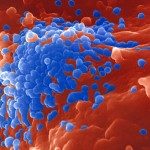Link to Pubmed [PMID] – 23840298
PLoS ONE 2013;8(6):e63461
Deamination of 5-methylcytidine (5MeC) in DNA results in a G:T mismatch unlike cytidine (C) deamination which gives rise to a G:U pair. Deamination of C was generally considered to arise spontaneously. It is now clear that human APOBEC3A (A3A), a polynucleotide cytidine deaminase (PCD) with specificity for single stranded DNA, can extensively deaminate human nuclear DNA. It is shown here that A3A among all human PCDs can deaminate 5-methylcytidine in a variety of single stranded DNA substrates both in vitro and in transfected cells almost as efficiently as cytidine itself. This ability of A3A to accommodate 5-methyl moiety extends to other small and physiologically relevant substituted cytidine bases such as 5-hydroxy and 5-bromocytidine. As 5MeCpG deamination hotspots characterize many genes associated with cancer it is plausible that A3A is a major player in the onset of cancer.
